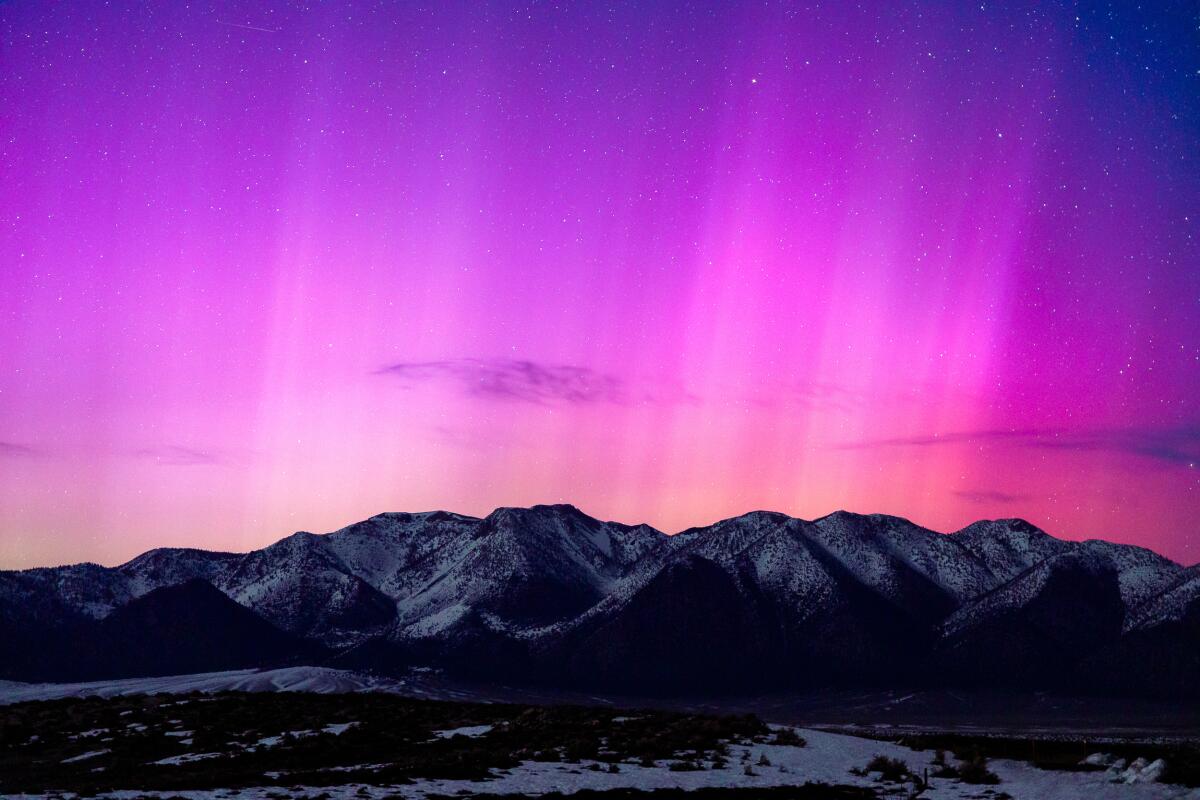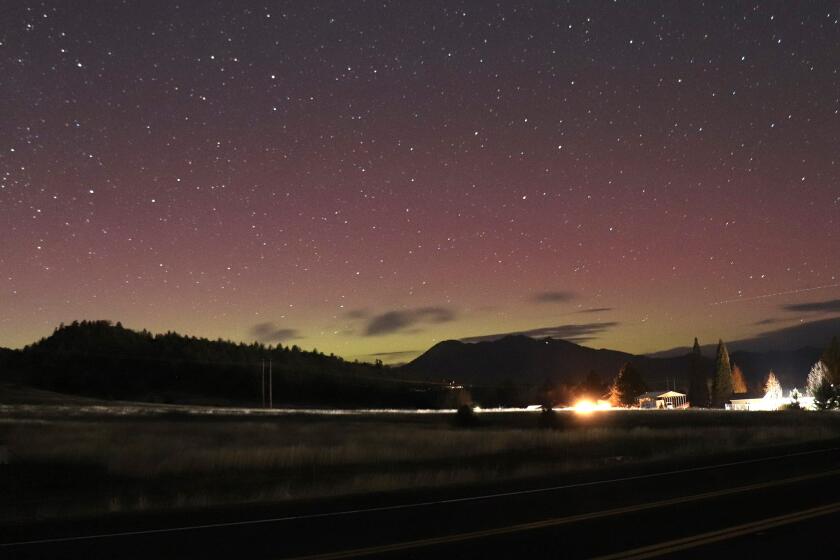‘Stay tuned’: California sees northern lights again, and experts say spectacle will repeat

- Share via
It had been only one month since Michael Steinberg had seen the northern lights for the first time — from Northern California, no less — before he heard there might be another opportunity for the rare sighting.
Warnings about another severe geomagnetic storm set off by eruptions on the sun meant that the aurora borealis — the scientific name for the dazzling lights typically seen only near the North Pole — was likely to be visible Sunday night, again from rare southern latitudes, including California.

So Steinberg, a 20-year-old student at Cal State Chico, drove west Sunday evening, away from Chico’s bright lights to try to capture the dazzling sight.
At about 9:30 p.m., he said he spotted the northern lights from his location in Orland, north of Sacramento. He captured bright pink and purple hues against the night sky with his long-exposure camera. It wasn’t quite as vibrant when seen with the naked eye, he said, but the phenomenon was still evident — and clearly more vivid than last month.
Northern Californians were able to see the aurora borealis, or northern lights, Thursday due to a severe geomagnetic spacial storm, scientists said.
“Once my eyes adjusted to the darkness, I could see the pink hue on the horizon looking north,” Steinberg said. “I’ve seen some incredible stuff ... but last night’s aurora takes the cake. [I] never thought I would see an aurora that bright in Northern California, much less twice in the span of a month.”
The sightings of northern lights in back-to-back months are the product of the sun entering its most active phase during its 11-year cycle, which probably will peak in late 2024 or early 2025, said Bill Murtagh, program coordinator for the Space Weather Prediction Center in Boulder, Colo., part of the National Oceanic and Atmospheric Administration.
“We’re in a ramped-up, elevated stage from now for the next four, five, six years,” Murtagh said. “We’ll certainly see more [auroras]. ... If you missed this one, stay tuned, there’s more to come.”
Increased instances of sun spots or eruptions on the sun create these spacial geomagnetic storms, which, depending on their strength, can disrupt the Earth’s magnetic field — and shift the display of the northern lights toward the equator, according to Murtagh and his team.
Although both geomagnetic storms this spring reached the severe level on the Space Weather Prediction Center’s scale, March’s storm barely qualified, Murtagh said. But Sunday’s storm was “almost twice the strength,” he said.
Although not exceptionally strong, he said, “it was just a really solid geomagnetic storm.” He said people from the Carolinas, northern Texas, northern Arizona, Colorado and Central California reported views of the northern lights late Sunday.
Jim Tang, a software engineer from Walnut Creek, was among them. He decided to drive east to try to find clear skies for the view.
“I was also looking at the cloud forecast,” Tang said. “It looked like most of Northern California was going to be clouded over.” He drove about four hours, almost to the Nevada border, to Topaz Lake, he said.
“When I stepped out and I noticed the aurora and I was kind of mind-blown,” said Tang, who has traveled to Alaska and Iceland to see the northern lights, but had never seen the dazzling sight from his home state.
“The aurora was definitely visible [with] the naked eye; that’s how amazing it was,” Tang said. He said it was strongest for about 15 minutes, when he captured bright pinks, purples and oranges with his camera, but he stayed about an hour to enjoy the view before driving back to the Bay Area.
NASA released findings Thursday that indicate magnetic explosions about one-third of the way to the moon cause the northern lights, or aurora borealis, to dance across the sky in spectacular shapes and colors.
These geomagnetic storms have the potential to affect spacecraft operations and degrade GPS navigation, as well as disrupt power systems, but space weather experts say those issues are rare and unlikely to be noticed by the general public.
NOAA’s Space Weather Prediction Center was still warning of an ongoing moderate geomagnetic storm Monday but said the storm was winding down, with the northern lights probably only visible from parts of Canada and Alaska by Monday evening.
But with more geomagnetic storms expected over the next few months and years, Tang is planning to keep up with space weather updates for another chance at the spectacular view — which has become easier to follow and share over the last two decades.
“With this solar cycle, we have [better] cameras, we have social media,” Tang said. “It’s pretty cool; we have this technology to document and know about these solar storms.”
More to Read
Sign up for Essential California
The most important California stories and recommendations in your inbox every morning.
You may occasionally receive promotional content from the Los Angeles Times.












